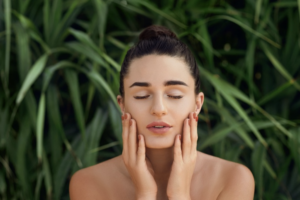Beauty is a universal concept, but its definitions and practices vary significantly across different cultures. Around the world, diverse societies have cultivated unique beauty rituals that reflect their traditions, natural resources, and historical influences. In this article, we embark on a global journey to explore traditional beauty practices for skin and hair, unveiling the wisdom passed down through generations and the unique ingredients that play a pivotal role in enhancing beauty.

Japanese Skincare Wisdom
Japanese skincare is renowned for its emphasis on simplicity, natural ingredients, and a holistic approach to beauty. Rituals like double cleansing, using gentle rice-based exfoliants, and layering lightweight moisturizers aim to achieve clear, radiant, and youthful skin. The incorporation of ingredients like green tea, seaweed, and sake reflects the country’s profound connection to nature.
Ayurvedic Beauty
Originating from India, Ayurveda combines holistic health and beauty practices. The focus is on balance among the three doshas (vata, pitta, kapha) to achieve optimal well-being and skin health. Oils like coconut, almond, and neem are used for massages and hair treatments, while turmeric, rosewater, and sandalwood are integral for skincare, creating a synergy of inner and outer beauty.
Indigenous Beauty Wisdom
Indigenous cultures worldwide have harnessed the power of their local flora and fauna to create potent beauty remedies. From African shea butter to Amazonian oils and Native American herbal infusions, these practices highlight the deep connection between people and their natural surroundings. These ingredients are often rich in antioxidants, vitamins, and nourishing properties that support healthy skin and hair.
Moroccan Hammam Traditions
The Moroccan hammam, a communal bathhouse, is a haven for cleansing and rejuvenation. Exfoliation with black soap, steam baths, and argan oil massages are integral to this tradition. Argan oil, known as “liquid gold,” is a key element in Moroccan beauty, renowned for its hydrating and anti-ageing properties.
Korean Beauty
Korean skincare, or K-beauty, has taken the world by storm with its elaborate yet effective routines. Incorporating steps like essence, sheet masks, and snail mucin serums, K-beauty aims for a glowing and hydrated complexion. Innovation and cutting-edge ingredients like snail secretion filtrate and fermented extracts are at the core of this regimen.
Maori Moko Tattoos
For the Maori people of New Zealand, beauty is intertwined with cultural identity. Moko tattoos are a form of body art that holds immense significance, telling stories of lineage, identity, and life experiences. These intricate tattoos are not just aesthetic adornments; they are sacred expressions of beauty and heritage.
Scandinavian Simplicity
Nordic countries embrace minimalism in their beauty routines, focusing on enhancing natural features. Cold-water plunges and saunas are part of Scandinavian skincare, promoting circulation and healthy skin. Ingredients like berries, birch sap, and sea buckthorn are cherished for their antioxidant-rich properties.
Middle Eastern Traditions
Middle Eastern beauty rituals often revolve around luxurious oils and floral essences. Rosewater, argan oil, and frankincense are prized for their rejuvenating qualities. Intricate henna designs on hands and feet are not only a form of body art but also a symbol of celebration and beauty.
Indigenous Australian Practices
The Indigenous peoples of Australia have utilized native botanicals for beauty and healing. Ingredients like tea tree oil, macadamia oil, and Kakadu plum are rich in antioxidants and vitamin C, offering protection against environmental stressors and promoting healthy skin and hair.
Brazilian Carnival Glamour
In Brazil, beauty is celebrated with vibrant colours and uninhibited self-expression, especially during Carnival. Beauty rituals incorporate tropical fruits like açai, cupuaçu, and coconut for both skincare and haircare. Brazilian women often emphasize body confidence and embrace their natural curves.
Conclusion
The world’s diverse cultures have woven intricate beauty practices into their fabric of life, reflecting traditions, values, and the deep connection between humanity and nature. From the simplicity of Japanese skincare to the luxurious oils of the Middle East, each culture’s rituals contribute to a global tapestry of beauty wisdom. These rituals not only enhance external appearance but also carry the legacy of generations, illustrating the timeless pursuit of self-care, self-expression, and the celebration of the human form
